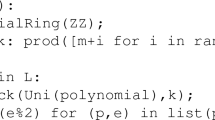Abstract
Completing Aronov et al.’s study on zero-discrepancy matrices for digital halftoning, we determine all (m,n,k,l) for which it is possible to put mn consecutive integers on an m×n board (with wrap-around) so that each k×l region has the same sum. For one of the cases where this is impossible, we give a heuristic method to find a matrix with small discrepancy.
Similar content being viewed by others
References
Aronov, B., Asano, T., Kikuchi, Y., Nandy, S.C., Sasahara, S., Uno, T.: A generalization of magic squares with applications to digital halftoning. Theory Comput. Syst. 42(2), 143–156 (2008)
Asano, T., Choe, S., Hashima, S., Kikuchi, Y., Sung, S.-C.: Distributing distinct integers uniformly over a square matrix with application to digital halftoning. SIG Technical Report AL-100. Information Processing Society of Japan (IPSJ) 2005(26), pp. 79–86 (2005)
Euler, L.: De quadratis magicis. Commentat. Arith. 2, 593–602 (1849). Presented to the St. Petersburg Academy in 1776
Author information
Authors and Affiliations
Corresponding author
Rights and permissions
About this article
Cite this article
Kawamura, A. Generalized Semimagic Squares for Digital Halftoning. Theory Comput Syst 49, 632–638 (2011). https://doi.org/10.1007/s00224-010-9290-7
Published:
Issue Date:
DOI: https://doi.org/10.1007/s00224-010-9290-7




